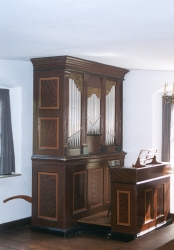  The United States
|
| The Seventeenth Century | The Eighteenth Century | David Tannenberg | General Characteristics of the Instruments |
The Seventeenth CenturyThe first European nations to colonize the new lands of the Western hemisphere were the Spanish, followed closely by the Portuguese. As they began their expansion to the western hemisphere, they first mobilized the principal institutions and powers of their respective nations: the Crown and the Church.
Very soon after representatives of the Church arrived in what is now Latin America, they began the process of converting and instructing the native people they encountered, and their instruction consistently included teaching them the music of the church. Records from the sixteenth through the eighteenth centuries tell us of the formation of choir schools along with the building of churches in the new land. Soon after the establishment of Spanish and Purtuguese colonies in the West, music in the missionary churches was supported by organs, the first ones being found in Brazil and Mexico. These were not only the first Spanish organs, they were the first organs of any national European tradition to be found in the Western hemisphere.208 Within the Spanish territories that would later become parts of the United States, there were fewer instruments than in those further south, but there were some thirty organs in what is now New Mexico. 209 Regrettably, none of these survive, and we are left to wonder what the organ in the United States would be like today if these early organs in the West had been preserved. The influence of Iberian organs on instruments in the United States has been virtually nonexistent, in spite of their early presence in this hemisphere. We also find some French instruments being brought to the New World during the seventeenth century, some few years after the Spanish instruments arrived in Latin America. French organs were received in Quebec and Montreal during the second half of the century.210 In between these two areas (Latin America and Canada), a somewhat different situation developed. Soon after 1588, when England had achieved a place of respect with the defeat of the Spanish Armada, a series of colonies was established in North America. Unlike those in Spanish and Portuguese territories, though, English colonies were not all established by the Crown. With regard to the established church and its attitude toward the organ, England was in a state of political flux throughout most of the seventeenth century. During the political changes of the seventeenth century, different factions of the church and state held conflicting ideas about the usefulness of the organ in Divine Worship.210 Their differences continued even in the new lands of North America, and you will find that even as the new culture began a process of stabilization in the eighteenth century, these differences persisted. |
| The Seventeenth Century | The Eighteenth Century | David Tannenberg | General Characteristics of the Instruments |
The Eighteenth CenturyBefore you start reading about the origin of organ-building in the United States, I want to remind you of one little fact so obvious that you might overlook it.
I told you it was an obvious fact, and it really is. Although citizens of the United States might be individually descended from many different peoples and cultures, the dominant national culture is English in origin. That simple fact has determined not only the language spoken in the United States but also the essential characteristics of its musical culture. The dominance of English culture over other influences from European traditions has been nowhere more complete than it has in the concept of what an organ is, how it should be designed, and what its purpose is. From the time the country was established as an independent nation until experimentation with other types began in the twentieth century, the organ in the United States revealed its English origin in every way. The true history of the organ in the United States, then, begins with the organ in England. You probably know the essential characteristics of the eighteenth-century English organ.212
Instruments with these characteristics were among the first and most influential to be found in the United States.
"Made in America" -- David TannenbergIn addition to these imported organs, instruments began to be built locally during the early eighteenth century. The first notable professional builder in the United States was Johann Gottlob Klemm, a German immigrant who, along with most Pennsylvania "deutsch," settled there because of the more open acceptance of dissenting religious ideas. Klemm had learned the organ building trade in his native Saxony, and some writers imply he actually worked with Gottfried Silbermann in his early years. After his arrival in this country in 1733, Klemm built several organs as well as other instruments. Though none of his instruments survive, his work is important in its influence on the organs of the first professional builder trained in the United States: David Tannenberg (1728-1804). David Tannenberg is today the most well-known and respected American builder of the eighteenth century. Although he was born in Saxony, Tannenberg came to the United States in 1733, learning the trade from Klemm and working with him until 1762. He thus became the first professional organ builder trained in North America. Tannenberg's instruments, only a few of which survive, represent the best of late colonial organs built in North America.214 You would do well to remember his name, and to seek out some of his surviving instruments as you travel.
As you might expect from his background in a German organ-building tradition, some of his instruments of have a pedal division that, although small, sets them apart from most English organs of the eighteenth century. Even though both Klemm and Tannenberg incorporated German characteristics in their instruments, these traits had no immediate effect on the general characteristics of organs in the United States during the Colonial period. For the most part instruments either built in the English Colonies or imported from England had English characteristics, whether the organs were large or small. After the United States became an independent nation - - in fact, well into the nineteenth century, changes in design elements continued to follow similar changes in English organs. It was not until the middle of the nineteenth century that a truly independent "American" organ was built in the United States. |
| The Seventeenth Century | The Eighteenth Century | David Tannenberg | General Characteristics of the Instruments |
| Great GG-f''' |
Swell g-f''' |
Pedal GG-c |
||||||||
|---|---|---|---|---|---|---|---|---|---|---|
| Open Diapason | 8 | Open Diapason | 8 | Subbass | 16 | |||||
| Stopped Diapason | 8 | Stopped Diapason | 8 | Violon | 8 | |||||
| Principal | 4 | Dulciana | 8 | |||||||
| Flute | 4 | Principal | 4 | |||||||
| Twelfth | 2 2/3 | Flute | 4 | |||||||
| Fifteenth | 2 | Fifteenth | 2 | |||||||
| Mixture IV | Sesquialtera II | |||||||||
| Trumpet | 8 | Hautboy | 8 | |||||||
Because this is a hypothetical instrument, it combines characteristics that probably never existed side by side in a "real" organ. Of course, in a smaller instrument, or one built for a remote location, there would probably have been no reeds. In a larger instrument, you would expect to see a third manual division (probably a "Choir") added next, rather than more stops to the existing ones. Taking this stoplist as it is, though, you should notice these general characteristics that apply to most eighteenth-century organs in the United States.
If you were to find an authentic eighteenth-century organ built in the United States, you might find some other variations in the scheme, of course. There might be only one manual division, and if that were the case, you would probably find some divided stops on the organ. If a Choir division were present, there might be another type of reed - - a Cremona or Krummhorn, for example. All in all, however, you would be able to see the basic scheme as presented here in the stoplist of most organs built in the United States in the eighteenth century. This was the state of the instrument at the time the country was established, and in a very real sense, this is what we can identify as the first type of "American" organ.
|
| The Seventeenth Century | The Eighteenth Century | David Tannenberg | General Characteristics of the Instruments |
copyright © 2000 AD James H. Cook
 The instrument in the photograph to the right is a small organ Tannenberg built in the late eighteenth century for the Moravian brothers in Salem, North Carolina. It's a small, one-manual instrument, best thought of as an ensemble instrument, or a continuo organ. I want you to notice a couple of characteristics as you look at the photo.
The instrument in the photograph to the right is a small organ Tannenberg built in the late eighteenth century for the Moravian brothers in Salem, North Carolina. It's a small, one-manual instrument, best thought of as an ensemble instrument, or a continuo organ. I want you to notice a couple of characteristics as you look at the photo.